Technology has taken on a central role in the visual arts, not only reshaping artistic forms and content but also redefining the meaning of art itself. In today’s digital ecosystem, this is seen in the evolution of plastic arts, which involve the manipulation of material for paintings, sculptures, and handicrafts.
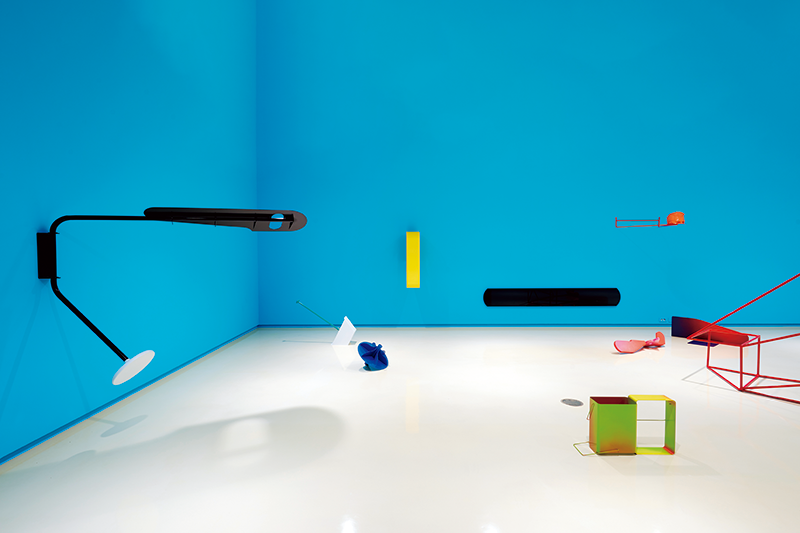
A view of Jackson Hong’s solo exhibition Autopilot, held in 2016 at the Perigee Gallery in Seoul’s Seocho District. Blurring the boundaries between design and fine art, Hong’s creations aim at eliciting social, political, and economic interpretations.
© Jackson Hong
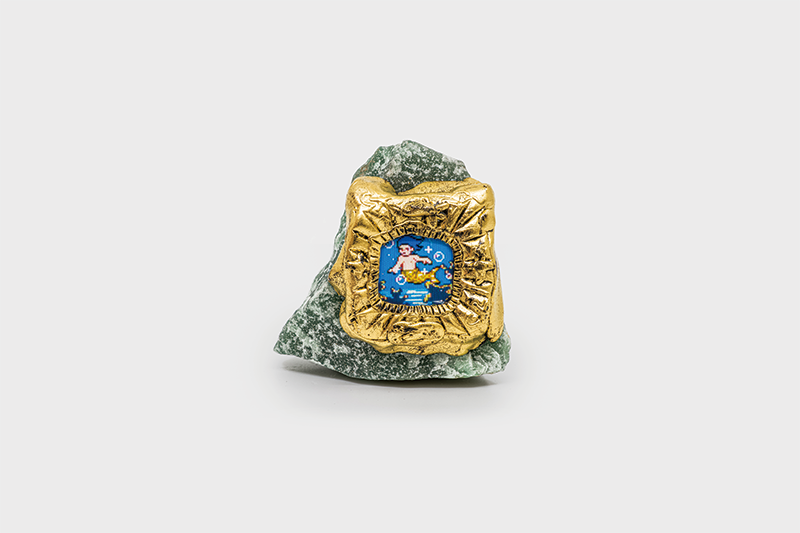
Golden Mermaid. Kim Han-saem. 2022. Glass, gold leaf, pigment print, resin, and aventurine. 7.5 × 7.5 × 6 cm.
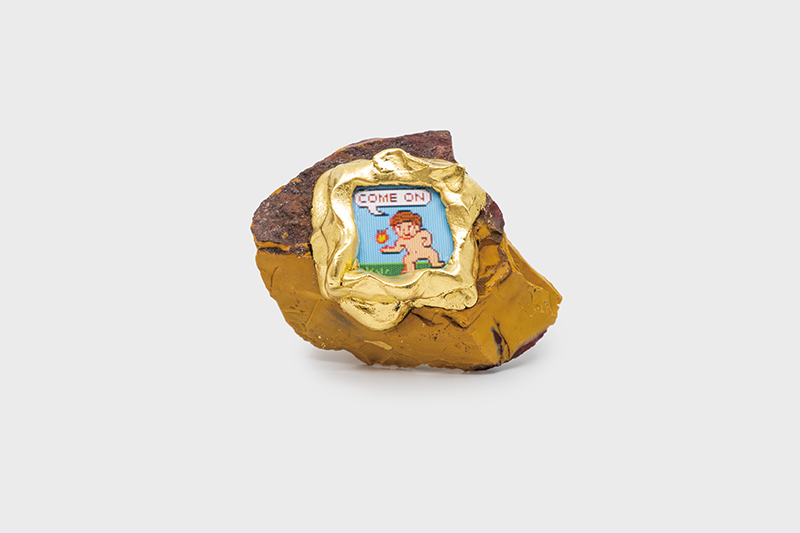
Come on. Kim Han-saem. 2022. Glass, gold leaf, pigment print, resin, and mookaite. 5 × 9.5 × 8 cm.
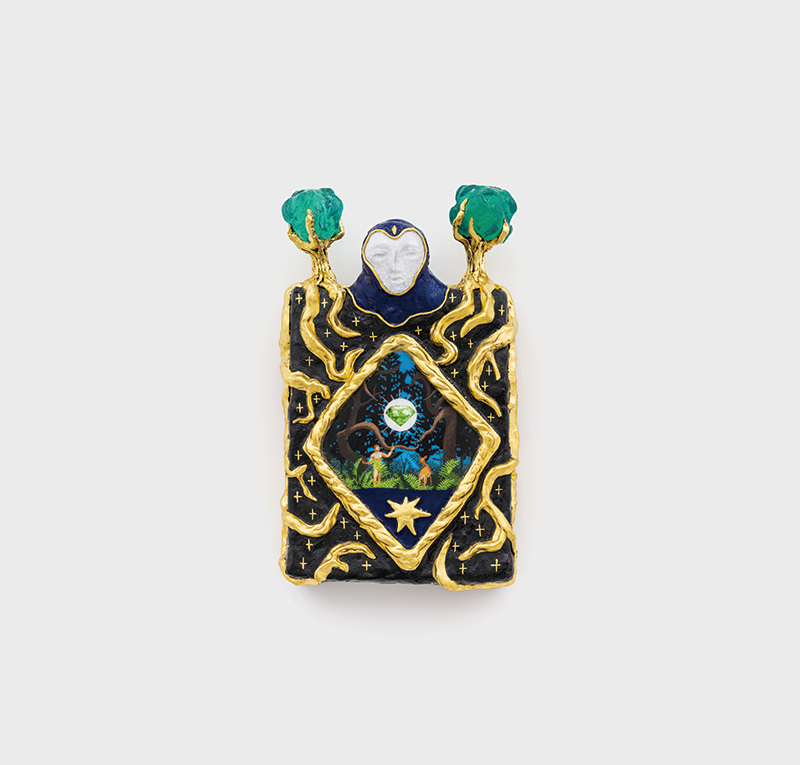
The Jewels in the Forest. Kim Han-saem. 2021. Acrylic, gold leaf, pigment print, and resin. 54 × 31 × 16 cm.
Kim Han-saem’s works draw upon subculture elements that he encountered in his childhood. He primarily focuses on transforming data to convert fantasy game narratives into pixel graphics.
© Kim Han-saem
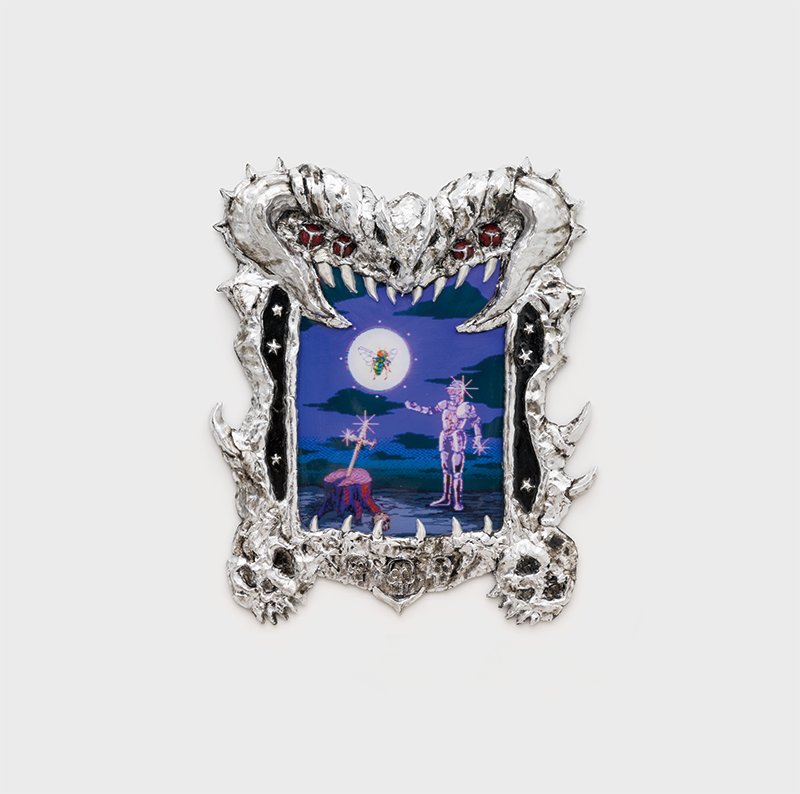
The Devil in Iron. Kim Han-saem. 2021. Aluminum leaf, pigment print, and resin. 97 × 80 × 11 cm.
The integration of digital technologies into the visual arts can be traced back to the 1990s, when Apple’s Macintosh revolutionized desktop computing. The decades following saw the emergence of 3D printing and computer numerical control (CNC) technology, which automates the control of machines through software programs. Since 2020, the commercialization of artificial intelligence imaging has ushered in a new era of visual arts.
There is no question that digital technologies have brought about the digitalization of the physical world and a departure from the material realm. This dramatic shift may give the impression that plastic arts, which deal with the material qualities of s, have grown out of sync with the times. However, those engaged in classical art forms constantly seek new approaches and actively reinterpret and engage with technology to produce their works.
With the potential of data to reduce the need for manual labor and streamline the artistic process, it should come as no surprise that a growing number of artists embraces digital technologies. In fact, many of those born in the 1980s and 1990s have started testing the limits of what can be done with digital technology, giving rise to all sorts of inventive artistic creations.
The use of technology undoubtedly blurs the boundaries between different art forms. On the surface, technology may seem to pose an existential threat to traditional art forms; but in reality, it reinforces their raison d’être by encouraging a reexamination of what constitutes art. Paintings can now be turned into sculptures, sculptures into data, and handicrafts into paintings.
The current landscape of traditional art forms includes an increasing number of works that depart from artistic conventions revolving around traditional materials and techniques. The gap between the digital and analog realms—the virtual and the physical—is becoming increasingly narrow.
Where Software Meets Art
Artist Kim Han-saem, who majored in painting at university, once confessed in an interview that he is not accustomed to working with oil on canvas. Having grown up in the digital age, he found himself more at ease creating paintings on the computer. After completing his academic studies, he focused on using the techniques with which he felt most comfortable.
Kim’s artistic process involves creating digital drawings in the style of 16-bit RPG (role-playing game) graphics. First, he uses software to draw an image on the computer and prints it on a sheet of paper, bringing his digital creation into the analog world. He then fuses the printed image onto physical material, such as stone, crystal, or medium-density fiberboard (MDF). Next, he crafts a frame by hand, adding aof depth to the work’s narrative. Kim’s approach introduces a tactile dimension to his work, giving it a unique quality that can be described as “touchable data.”
With a degree in industrial design, Jackson Hong pushes the boundaries between design and art. His work explores the malleability of s and how they can be interpreted differently, as well as the relationship between s and people. He also explores the visual representation of the manufacturing process of s through the use of data.
Much like an industrial designer creating a product, he begins by gathering the data required to bring an idea to life. This data must then be refined through a process that requires a high level of skill and expertise. For example, Hong uses CNC machines to cut metal sheets to size based on the data he feeds into the machinery’s software program, and then expertly shapes, bends, and welds them by hand into the desired form.
The data in Hong’s works serve as a precise tool but are also a reflection of the artist’s intention to break free from the constraints of norms and conventions. This is evident in the architectural floor plans for his Cross Hatching series, which he produced by deliberately employing digital errors. It was an act of defiance against standardization and expectations of perfection meant to encourage different interpretations. Hong’s drawings are—beyond their functional purpose—like X-rays of his imagination.
3D Printing
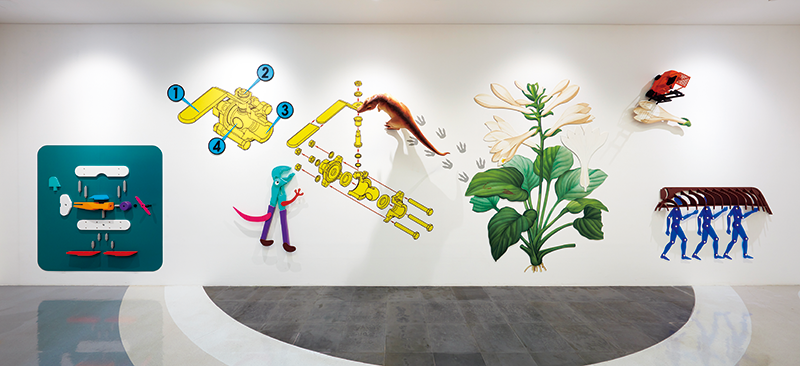
A look into the Drawing and Playing with Jackson Hong exhibition, held in 2018 at the Buk-Seoul Museum of Art (SeMA). Geared toward children, this exhibition encouraged creative thinking and challenged preconceptions by reinterpreting various s.
Courtesy of Buk-Seoul Museum of Art (SeMA); Photo by Kim Sang-tae
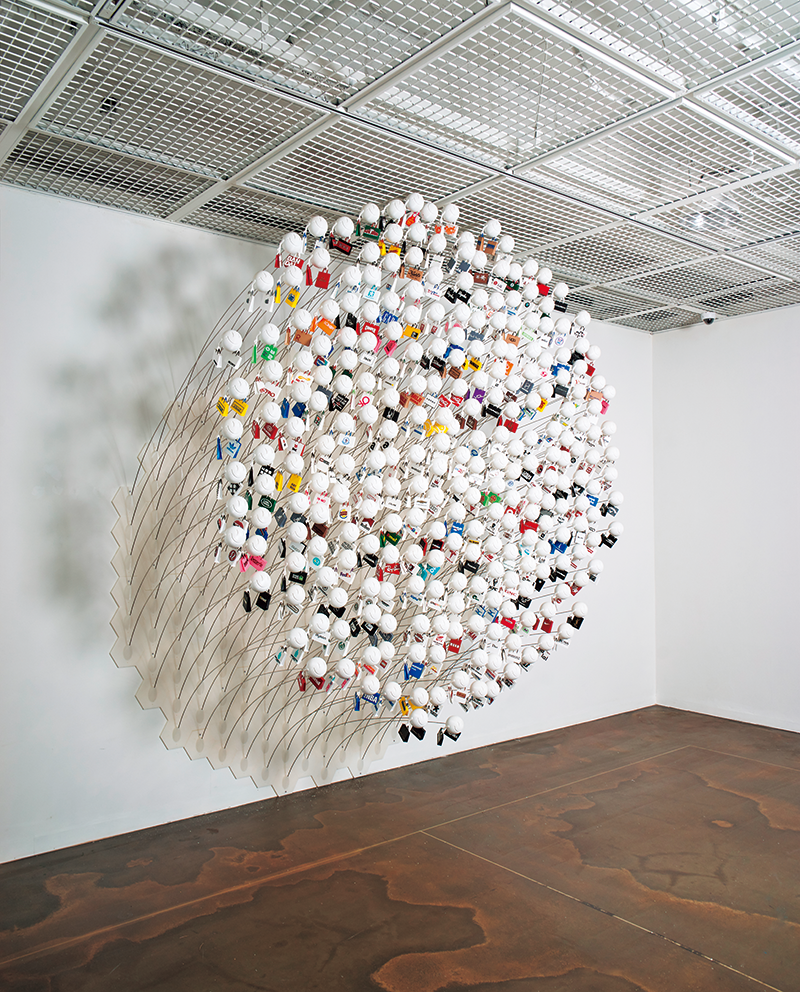
MANJOY Project. Kim Ji-min. 2021. PLA filament and stainless-steel wire. Variable dimensions.
A work on display at Kim Ji-min’s solo exhibition ENVy⁷, held in 2021 at UARTSPACE in Cheongdam-dong, Seoul. Kim relied on 3D printing toartworks intended to serve as a satirical critique of consumerism.
Courtesy of Kim Ji-min
Kim Ji-min, who majored in sculpture, long relied on a labor-intensive stitching technique for sewing brand labels together to produce artworks. But he abandoned this method while completing a recent project that examines the psychological factors behind consumerism. The project, called “MANJOY,” demonstrates an effective application of 3D printing. The use of digital technology enabled Kim to quickly reproduce identical icons, allowing him to convey his message about consumerism in a humorous way.
The limitations of 3D printing have prevented Kim from fully embracing it, so he continues to incorporate traditional methods into his work. To produce his serial work Skull, he used traditional sculpting techniques, which he then converted into digital data with a 3D scanner toa separate 3D printed work titled Coloring N. 108. Thanks to the versatile nature of digital data, which allows it to be easily adapted to different scales, Kim later used the same data to produce larger works such as Inside Out.
Serin Oh, who studied traditional East Asian painting, metalwork, and jewelry, combines various elements and techniques in her works tosurreal visual effects. Her 2022 solo exhibition Forest Temperature Bunker, at the BYFOUNDRY gallery in Hannam-dong, featured artworks that seamlessly blended ceramics and 3D prints. They were meant to serve as a metaphorical interpretation of human contradictions in the face of environmental issues, a theme closely related to the one explored in her previous exhibition, Imitation and Deception (Mobanggwa sogimsu).
From a distance, it is not easy to discern which parts in Oh’s work are ceramic and which are 3D printed. To produce the latter, the artist relies on open-source 3D modeling data available on the internet. She uses 3D software to combine and modify the data, and then prints it using a Fused Deposition Modeling (FDM) printer, which works by heating a raw material at a temperature above its melting point and stacking it in uniform s todifferent shapes. The resulting artwork possesses a surreal quality due to the printing of different elements with varying resolutions under uniform conditions.
Weaving Pixels
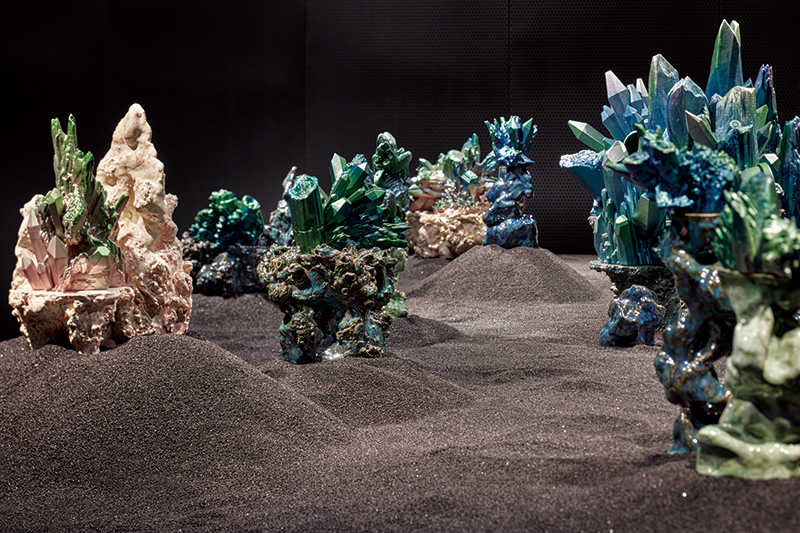
Serin Oh has long been interested in how original artworks are replicated and transformed in the context of capitalism. She recently expanded into combining traditional craft techniques with technology. This photo shows one of her works at her solo exhibition Forest Temperature Bunker, held at BYFOUNDRY in Hannam-dong in 2022.
© Roh Kyung
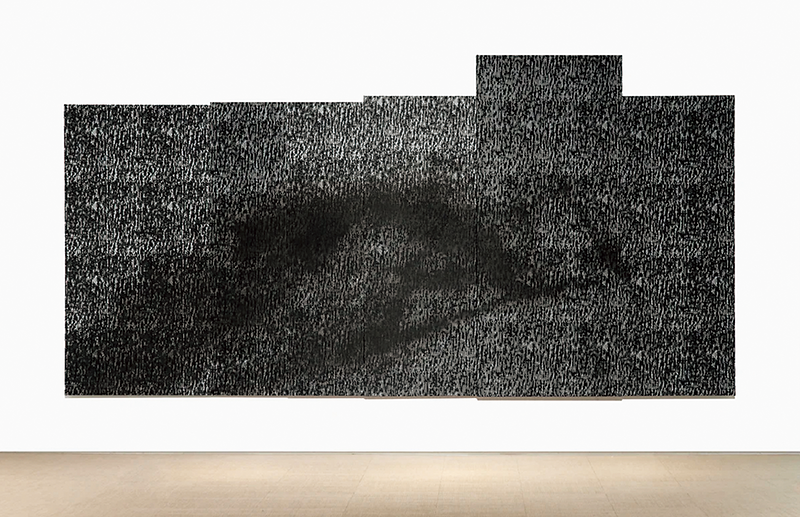
Sudden Rules-Bay-2. Cha Seung-ean. 2017. Polyester filament yarn and dye. 230 × 455 cm.
Cha Seung-ean’s works appear to be two-dimensional paintings but they are woven. By navigating the boundaries between East and West, the visual and the tangible, as well as the spiritual and material realms, Cha aims to re-examine the legacy of 20th century art in an exploration of what constitutes meaningful abstract paintings today.
© Cha Seung-ean
Cha Seung-ean is an artist who specializes in reinterpreting traditional weaving techniques within a contemporary context. Cha, who has a background in fiber art and painting, says she uses weaving to re 20th-century abstract paintings that are of particular interest to her.
Her most famous work, Sudden Rules-Bay-2, is a fusion two paintings: American abstract ist artist Helen Frankenthaler’s The Bay and Korean artist Rhee Seund Ja’s Subitement la Loi (A Sudden Law). The process involved digitizing Rhee’s painting and converting it into data based on its pixel configuration. The data was then used to weave a sheet of fabric with a Jacquard loom, onto which Cha skillfully applied Frankenthaler’s soak-stain painting technique. Through this experiment, the artist sought to combine weaving and dyeing to symbolize the coexistence of order and chance on the same canvas.
Another pivotal theme in Cha’s work is the interplay between language and weaving. For example, she uses a converter to encode phrases, such as “Before your birth” or “Your love is better than life,” and reconfigures them into weaving design drafts that she can incorporate into her works.
Cha’s experimentation is an attempt to blur the lines between language and art. As technology continues to evolve, Korean artists will no doubt find ways of combining traditional arts and the latest technology tosomething new and unexpected.